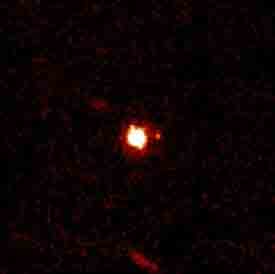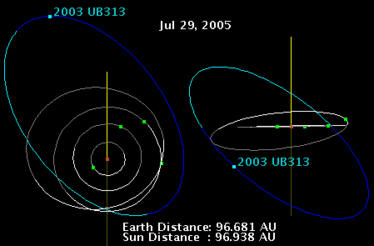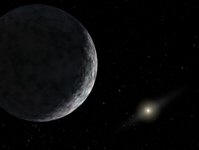|
         
> The Sun
> Mercury
> Venus
> Earth
> Mars
> Jupiter
> Saturn
> Uranus
> Neptune
> Pluto
> The 10th Planet?
> Asteroids
> Comets
> The 'Edge'
  
|
2003 UB313
(also written 2003 UB313) is a trans-Neptunian object (TNO) which
California astronomers at Mount Palomar observatory describe as
"definitely bigger" than the planet Pluto. The object has already been
dubbed the tenth planet by the discoverers, NASA, and some media outlets,
but it is not yet clear whether it will be widely accepted as a new planet
or not. It has at least one moon, which will enable investigators to
measure the mass of the system.
No official name for the object has yet been approved, although its
discoverers have submitted a potential name to the International
Astronomical Union (IAU), who oversee astronomical naming conventions.
Claims that 2003 UB313 has been named 'Xena' or 'Lila' are incorrect; both
have been used informally by its discoverers but neither is the name
submitted to the IAU. A ruling on what to name 2003 UB313 is
currently being delayed pending decisions on whether to promulgate a
formal definition of the term 'planet' and the status of this object under
such a definition.
The diameter of 2003 UB313 is undetermined, but a preliminary
analysis of recent observations by the Spitzer space telescope indicate
that its diameter is approximately 2,700 km, or about 20% larger than
Pluto. Initial observations show that methane ice is present on the
object's surface. This makes 2003 UB313 more similar to Pluto
than previously discovered large outer solar system planetoids.
Further observations released in October 2005 revealed that the object had
a moon, S/2005 (2003 UB313) 1, nicknamed "Gabrielle."
Scientists plan to use this information to determine the mass of 2003 UB313.
Discovery
2003 UB313 was discovered by the team of
Michael Brown, Chad Trujillo, and David Rabinowitz on January 5, 2005 from
images taken on October 21, 2003, and the discovery was announced on July
29, 2005, the same day as two other large TNOs, 2003 EL61 and
2005 FY9. The search team has been systematically scanning for
large outer solar system bodies for several years, and had previously been
involved in the discovery of several other very large trans-Neptunian
objects, including 50000 Quaoar, 90482 Orcus, and 90377 Sedna.
 |
2003 UB313
Time-lapse images showing the
movement of 2003 UB313 against the stars. |
Routine observations were taken by the team on October 21, 2003 using the
48-inch Samuel Oschin reflecting telescope at Mount Palomar Observatory,
California, but the object captured on the images was not discovered at
that point due to its very slow motion across the sky: the team's
automatic image searching software excluded all objects moving at less
than 1.5 arcseconds per hour to reduce the number of false positives
returned. However, when 90377 Sedna was discovered it was moving at 1.75
arcsec/hour, and in light of that the team decided to reanalyze their old
data with a lower limit on the angular motion, sorting through the false
positives by eye. In January 2005, this re-analysis revealed 2003 UB313's
slow motion against the background stars.
Follow-up observations were then carried out to make a preliminary
determination of its orbit, which allowed its distance and size to be
estimated. The team had planned to delay announcing their discovery until
further observations had been made which would have allowed more accurate
determinations of the body's size and mass, but were forced to bring
forward the announcement when the discovery of another object they had
been tracking (2003 EL61) was announced by another group in
Spain. Brown's group later accused the Spanish group of a serious breach
of ethics in connection with the discovery of 2003 EL61 and
asked that they be stripped of credit for its discovery
[Top]
Classification
2003 UB313 is classified as a scattered disk
object (SDO), a category of TNO which are believed to have been
"scattered" from the Kuiper belt and into more distant and unusual orbits
following gravitational interactions with Neptune as the solar system was
forming. Although its high orbital inclination is unusual among the
current known SDOs, theoretical models suggest that objects which were
originally near the inner edge of the Kuiper belt are scattered into
orbits with higher inclinations than objects from the outer belt. Inner
belt objects are expected to be generally more massive than outer belt
objects, and so astronomers expect to discover more large objects like
2003 UB313 in high-inclination orbits.
As 2003 UB313 appears to be larger than Pluto, it might come to
be considered as the tenth planet in the Solar System, and was initially
described as such by NASA and in media reports of its discovery. However,
this is not a given, since the status of Pluto as a planet has been
subject to debate for some time. Some astronomers believe that there are
large numbers of undiscovered TNOs as large as or larger than Pluto.
Classifying all of them as planets is seen as unwieldy by many.
The IAU has been reviewing the definition of the term 'planet' because of
the increasing expectation that something bigger than Pluto would be
found. The IAU was expected to move quickly to promulgate a definition,
but this is now uncertain. Until this definition is available, the IAU
will continue to regard all objects discovered at a distance greater than
40 AU as part of the general Trans-Neptunian population.
The president of the IAU's working group to define the term planet has
proposed that Pluto keep its present classification for historical
reasons, and that nothing else be named a planet. This view is shared by
at least one other member of the group [Top]
Name
The object currently has the provisional designation 2003
UB313, granted automatically according to the IAU's naming
protocols for minor planets. The next step in the object's identification
will be the external verification of its orbit and assignment of a
permanent designation number. Should 2003 UB313 be treated as any other
minor planet, its discoverers will then have the exclusive right to
propose a name during a ten year window that begins with its permanent
numbering, subject to the approval of the Committee on Small Bodies
Nomenclature of the IAU's Division III. According to the IAU rules, TNOs
must be named after deities of creation, with the exception of plutinos,
which are named after underworld deities.
The potential for the object's classification as a major planet, however,
may well force a deviation from adhering to the same steps, timelines and
approval procedures as those that apply to garden-variety
asteroids and comets. The IAU has released a short statement regarding the naming of
2003 UB313, indicating the object will not be named until it
has been decided if it is a planet or not.
The discoverers have already submitted their name proposal for 2003 UB313,
which under IAU rules cannot be publicly disclosed. Brown's team had
violated this rule in 2003 when they announced the name "Sedna" for that
planetoid before it had officially been approved, prompting some criticism
within the astronomical community; the IAU later relaxed its rules and
permitted an expedited process for major new discoveries. The discovery
web page URL uses the name "Planet Lila" (named after Michael Brown's
newborn daughter, Lilah), and the team have also been informally referring
to the object by the codename Xena, after the television series Xena:
Warrior Princess, but neither is the name put forward to the IAU.
Two days after announcing the discovery, Brown discussed his team's ideas
about naming the objects on his website:
-
"If the object falls under the rules for other Kuiper belt objects,
however, it must be named after some figure in a creation mythology.
We have decided to attempt to follow that ruling scheme. […] One such
particularly apt name would have been Persephone. In Greek mythology
Persephone is the (forcibly abducted) wife of Hades (Roman Pluto) who
spends six months each year underground. The mourning of her mother
Demeter causes the dead of winter. The new planet is on an orbit that
could be described in similar terms; half of the time in the vicinity
of Pluto and half of the time much further away. Sadly, the name
Persephone was used in 1895 as a name for the 399th known asteroid.
The same story can be told for almost any other Greek or Roman god of
any consequence […] Luckily, the world is full of mythological and
spiritual traditions. In the past we have named Kuiper belt objects
after native American, Inuit, and [minor] Roman gods. Our new proposed
name expands to different traditions, still."
He added later on his website that IAU
lacks consensus on what the object is, and even which committee should
be charged with approving its name. The committee which oversees major
planets has suggested that if this object is classified as a major
planet, the naming should continue the Greco-Roman tradition for
planets. Brown indicated in a recent article that he would propose the
name Persephone if this tradition were to be upheld, despite the fact
that this name has been assigned to the 399th known asteroid.
[Top] Orbit
2003 UB313 has an orbital period of 557 years,
and currently lies at almost its maximum possible distance from the Sun
(aphelion). It is currently the most distant known solar system object
from the Sun at a distance of 97 astronomical units, although about forty
known TNOs (most notably 2000 OO67 and Sedna), while currently
closer to the Sun than 2003 UB313, have greater average orbital distances.
 |
Orbital Characteristics
Position of 2003 UB313 on 29 July 2005. On the
left is the view from "above" the plane of the solar system, while
on the right is the view from "in front". Darker blue indicates the
part of the orbit below the ecliptic plane. Also shown are Saturn,
Uranus, Neptune, and Pluto. |
Like Pluto, its orbit is highly eccentric, and brings it
to within 35 AU of the Sun at its perihelion (Pluto's distance from the
Sun varies between 29 and 49.5 AU, while Neptune orbits at just over 30
AU). Unlike the terrestrial planets and gas giants, whose orbits all lie
roughly in the same plane as the Earth's, 2003 UB313's orbit is
very inclined—it is tilted at an angle of about 44 degrees to the
ecliptic.
The new object currently has an apparent magnitude of about 19, making it
bright enough to be detectable even in some amateur telescopes. While it
would be a difficult object to spot visually, a telescope with an 8" lens
or mirror and a CCD can image 2003 UB313 in dark skies. The
reason it had not been noticed until now is because of its steep orbital
inclination: most searches for large outer solar system objects
concentrate on the ecliptic plane, in which most solar system material is
found. [Top] Size
The brightness of a solar system object depends both on
its size and the amount of light it reflects (its albedo). If the distance
to an object and its albedo are both known, its radius can easily be
determined from its apparent magnitude, with a higher albedo implying a
smaller radius. Currently, the albedo of 2003 UB313 is unknown,
and so its true size cannot yet be determined. However, astronomers have
calculated that even if it reflected all the light it receives
(corresponding to the maximum albedo of 1.0 or 100%), it would still have
to be about as large as Pluto (2390 km). In fact, its albedo is almost
certainly less than 1.0, so the new object is likely to be larger than
Pluto. The current best guess is that the albedo is similar to Pluto's,
that is, approximately 0.6, which corresponds to a diameter of 2900 km.

Spitzer space telescope observations should provide an upper bound on the
size of 2003 UB313. A first round of observations failed to
detect the new object due to a technical glitch, but new observations were
made on August 23 and August 25, 2005 and are currently being analyzed. A
preliminary analysis indicates a size of 2,700 km (which is about 20%
bigger than Pluto's 2,274 km diameter). This figure is still subject to
change, but Michael Brown is quoted as saying "if it's not larger than
Pluto, then I'll eat my telescope".
To better determine 2003 UB313's radius, the discovery team
have been awarded observing time on the Hubble Space Telescope. At a
distance of 97 AU, an object with a radius of about 3000 km would have an
angular size of about 40 milliarcseconds, which is directly measurable
with HST: although resolving such small objects is right at the limit of
Hubble's capabilities, sophisticated image processing techniques such as
deconvolution can be used to measure such angular sizes fairly accurately.
The team previously applied this technique to 50000 Quaoar, using the
Advanced Camera for Surveys to directly measure its radius.
[Top] Surface
The discovery team followed up their initial
identification of 2003 UB313 with spectroscopic observations
made at the 8 m Gemini North Telescope in Hawaii on January 25, 2005.
Infrared light from the object revealed the presence of methane ice,
indicating that the surface of 2003 UB313 is rather similar to
Pluto, which was the only TNO already known to show the presence of
methane. Neptune's moon Triton is probably related to Kuiper Belt objects,
and also has methane on its surface.
 |
The infrared spectrum of 2003 UB313,
compared to that of Pluto, shows the marked similarities between the
two bodies. Arrows denote methane absorption lines. |
Unlike the somewhat reddish Pluto and Triton, however,
2003 UB313 appears almost grey. Pluto's reddish colour is
believe to be due to deposits of tholins on its surface, and where these
deposits darken the surface, the lower albedo leads to higher temperatures
and the evaporation of methane deposits. In contrast, 2003 UB313
is far enough away from the Sun that methane can condense onto its surface
even where the albedo is low. The condensation of methane uniformly over
the surface reduces any albedo contrasts and would cover up any deposits
of red tholins.
Methane is very volatile and its presence shows either that 2003 UB313
has always resided in the distant reaches of the solar system where it is
cold enough for methane ice to persist, or that it has an internal source
of methane to replenish gas that escapes from its atmosphere. This
contrasts with observations of another recently discovered
Kuiper Belt
object, 2003 EL61, which reveal the presence of water ice but
not methane. [Top] Moon
During 2005, the adaptive optics team at the Keck
telescopes in Hawaii carried out observations of the four brightest
Kuiper
belt objects (Pluto, 2005 FY9, 2003 EL61, and 2003
UB313), using the newly commissioned laser guide star adaptive
optics system. Observations taken on 10 September revealed a moon in orbit
around 2003 UB313, provisionally designated S/2005 (2003 UB313)
1. In keeping with the "Xena" nickname already in use for 2003 UB313,
the moon was nicknamed Gabrielle by its discoverers, after the television
warrior princess' sidekick.
The satellite is about 60 times fainter than 2003 UB313, and
its diameter is estimated to be approximately eight times smaller. Its
orbital period is currently crudely estimated to be about two weeks, but
further observations are planned which will allow a much better
measurement on the period. Once astronomers know the period and the
semimajor axis of the satellite's orbit, they will be able to determine
the mass of the system.
Astronomers now know that three of the four brightest Kuiper belt objects
have satellites, while among the fainter members of the belt only about
10% are known to have satellites. This is believed to imply that
collisions between large KBOs have been frequent in the past. Impacts
between bodies of the order of 1000 km across would throw off large
amounts of material which would coalesce into a moon. A similar mechanism
is believed to have led to the formation of Earth's own Moon when the
Earth was struck by a giant impactor early in the history of the solar
system. [Top] External
links
[Back] [Top] [Next] |




